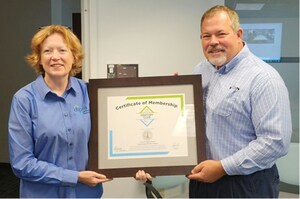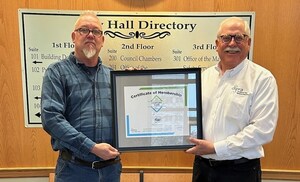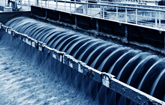GOLDEN, Colo., March 19, 2018 /PRNewswire-USNewswire/ -- Earlier this month, a report titled "Water Main Break Rates in the USA and Canada" was released by Utah State University with sponsorship by the Uni-Bell PVC Pipe Association (Uni-Bell). As an update of a similar study released in 2012, the 2018 study could have been a helpful tool for those wrestling with infrastructure renewal and replacement decisions. An apparent bias, however, in the study sponsorship skews the methods and results, according to L. Gregg Horn, P.E., VP of Technical Services for the Ductile Iron Pipe Research Association (DIPRA).
"It's hardly surprising that a study sponsored by Uni-Bell finds favorable results for their product, but certain changes to and omissions in the report raise significant questions, leaving us to wonder how they affect the data," says Horn. He notes that there were problematic issues in Utah State's 2012 study, but the follow-on 2018 study then covers the same ground without addressing the previous problems. What would have been expected, is that the researcher would take the next step forward with a later study, correcting methodology and data gathering errors, and producing an updated study that provides real benefit to the industry. This did not happen, and perhaps went in the opposite direction, as information that was included in 2012 was not included in the 2018 study.
"For instance, the study excludes primary failure modes for PVC pipe. These exclusions include – but are not limited to – the absence of data on construction damage, the tapping of service lines, and joint leakage, all of which are failure modes reported to be among primary problems for PVC pipe. Survey respondents were specifically directed not to include findings on these failure modes," says Horn.
"Even more notable is that the 2018 report does not itemize the various causes for the number of breaks for each pipe material, as it did in the 2012 edition. This last point is particularly telling as the researcher asked for and reported on this information in the 2012 survey. This resulted in the survey stating that nearly 28% of the failures of Ductile iron pipe were attributed to circumferential cracks, which is virtually impossible, as those would be attributed to cast iron pipe, the earlier generation of pipe now replaced by modern Ductile. In the 2018 version, that level of detail was not provided. It is another very curious omission."
Check Out the Sponsors
Horn notes that it's also interesting that the 2018 study sponsors are not acknowledged until page 45 of the 47-page report. In addition to Uni-Bell, the Water Finance Research Foundation is listed. This organization does not disclose supporters on its website. Both organizations were acknowledged for support of the initial 2012 report on water main break rates.
The primary researcher for the 2012 and 2018 reports is Steven Folkman of Utah State University. A review of Folkman's related conference papers and presentations to plastic pipe associations and companies show a history of engagement with the PVC pipe industry and vice-versa.
Connecting the Dots
In section 5.0 of the 2018 report (page 24), "Computing Water Main Failure Rates," Horn notes the request to respondents not to report failures on construction damage, tapping of service lines, or joint leakage. These are typically reported as major issues with the use of PVC pipe, especially tapping-related failures and joint leakage due to over-belling of PVC during installation. Below are observations:
- Construction damage: Again, these were specifically requested to be excluded. The question that remains is then how did the researchers conclude that the percentage of failure attributed to construction damage for PVC and its nearest competitor, Ductile iron, were the same? The data would be shown in a reputable report.
- Tapping issues: It isn't surprising that tapping related failures would be avoided in the survey. Historically, it is one of the most often cited problems. There are even records of workers being injured when tapping PVC pipe, while tapping Ductile iron is safe.
- Joint leakage: Folkman has done previous work for the PVC industry. These are noted in his conference papers: "Predicting Stresses in PVC Pipe that are Over-Belled," Uni-Bell PVC Pipe Association, 39th Annual Meeting, Arizona, April 2011; and "Analytical Model of Stresses Caused By Over-Belling of PVC Pipe," for the Plastic Pipes XV Conference in Canada, Sept. 2011. With regard to these known issues, it is interesting that they were specifically excluded from this latest report.
Eyes Up and Ahead
There are a plethora of questions that need to be answered regarding the accuracy of this study. Regardless, the favoritism shown for PVC is an easy line to draw from the study sponsors to a researcher who has labored for years on behalf of the plastics industry. It is with this perspective that a shadow of doubt should be cast as to the validity of the study, and especially with concern for the decisions on infrastructure improvements that could be made on its basis.
In contrast, DIPRA's focus is an "eyes up and ahead" approach to understand and solve issues with advances in knowledge and technology. First with cast iron, and now with modern Ductile iron, it's an industry of innovation, not deception.
"DIPRA is a research organization that has focused on improvements to recommend to the industry," says Patrick Hogan, DIPRA president. "Our intent is raise the bar based on what we know and continue to explore. We are looking to incorporate the advances of technology into further improvements, and help our local government and utility officials, and their professional engineers, to make the best possible recommendations for the safety, affordability and reliability of water delivery."
About DIPRA: Founded in 1915, the Ductile Iron Pipe Research Association (DIPRA) has served as a resource and technical advisor to the water industry. DIPRA also provides representation on standards-making committees as well as technical research on a variety of applications-based topics. While DIPRA member companies have different names and locations, they share a common commitment to produce and deliver the finest quality water and wastewater pipe material in the world, Ductile Iron Pipe, and at the greatest possible value to its purchasers.
SOURCE Ductile Iron Pipe Research Association (DIPRA)
WANT YOUR COMPANY'S NEWS FEATURED ON PRNEWSWIRE.COM?
Newsrooms &
Influencers
Digital Media
Outlets
Journalists
Opted In






Share this article